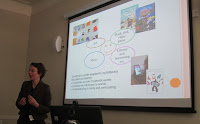At the QQML conference. Leena Pylkkö (whose coauthor was Pauli Pylkkö) talked on Teaching Media Literacy, Did we Forget Literacy. She is at Turku City Library (Finland) and she was talking about their multiliteracy initiative. Multiliteracy is part of a "culture path" designed in collaboration with local schools. Children come at different stages of education, and activities are attended by 82% of children at 2nd and 4th grade (8/9 years and 10/11 years). For older children, there is QR code orientiering and a session on the representation of people in the media.
Pylkkö described some of the activities e.g. making a video blog; making a picture collage of representations in the media; filling out activity sheets on a tablet.
She has been reflecting on how this connects to thinking skills, information literacy and reading skills. Children say that the most difficult things in the activities are e.g. thinking what to say on the vlog; understanding text (so challenges that have been around a long time - how to think and understand).
In order to explore these issues further Pylkkö contemplated Kuhlthau's model, but decided that a more suitable framework for her own context were Nelson Goodman's ideas. These are that paintings, photos etc. are worlds of their own each with their own system of codes. Thus, Understanding worlds = reading their symbol systems, and Not understanding = not understanding the symbol system.
Adapted to libraries; the librarian can be the person who introduces the learner to worlds and their symbols. This provides a framework for the librarian, and "literacy" is seen as competence in a specific semiotic system. Pylkkö also felt this helped to distinguish between ICT and literacy (and she talked at this point OECD and other research which showed that ICT use did not necessarily bring improvement in learning outcomes).
Pylkkö concluded that, using this approach, you would also embrace "traditional" concepts and content. She said that "Knowledge IS literacy, that is, ability to use different symbol systems in order to "make worlds"" - the worlds were e.g. "the library", "music", "art", "Books, DVDs, Video games" (the latter could be more than one world, also). Thus the librarian could concentrate on introducing the children to each of these worlds.
The presenter has written a paper (based on a talk at this conference 2 years ago) on a similar topic here http://www.qqml.net/papers/December_2014_Issue/3412QQML_Journal_2014_Pylkko_Dec_909-916.pdf

No comments:
Post a Comment